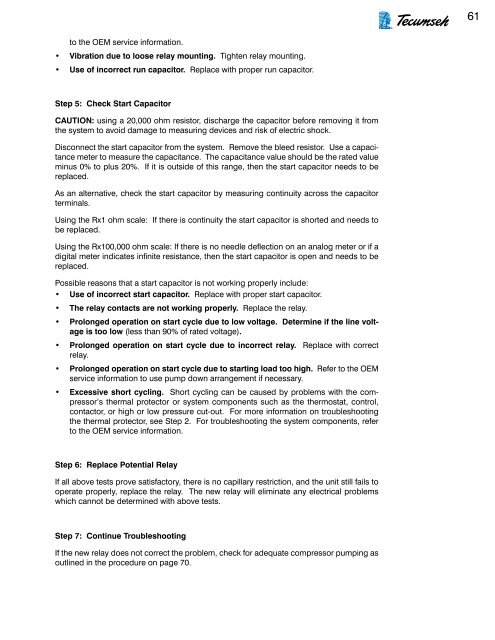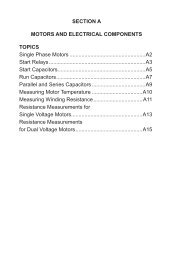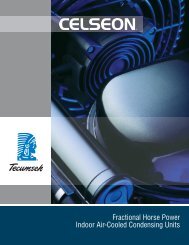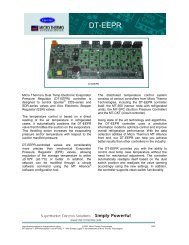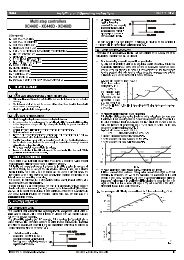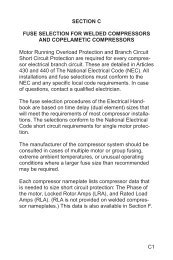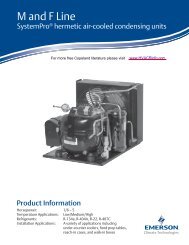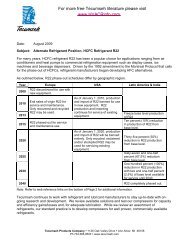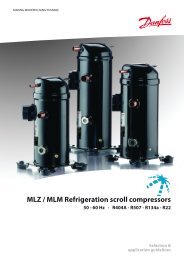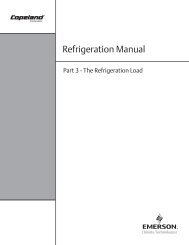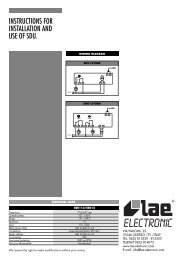Hermetic Compressor - Tecumseh
Hermetic Compressor - Tecumseh
Hermetic Compressor - Tecumseh
Create successful ePaper yourself
Turn your PDF publications into a flip-book with our unique Google optimized e-Paper software.
61<br />
to the OEM service information.<br />
• Vibration due to loose relay mounting. Tighten relay mounting.<br />
• Use of incorrect run capacitor. Replace with proper run capacitor.<br />
Step 5: Check Start Capacitor<br />
CAUTION: using a 20,000 ohm resistor, discharge the capacitor before removing it from<br />
the system to avoid damage to measuring devices and risk of electric shock.<br />
Disconnect the start capacitor from the system. Remove the bleed resistor. Use a capacitance<br />
meter to measure the capacitance. The capacitance value should be the rated value<br />
minus 0% to plus 20%. If it is outside of this range, then the start capacitor needs to be<br />
replaced.<br />
As an alternative, check the start capacitor by measuring continuity across the capacitor<br />
terminals.<br />
Using the Rx1 ohm scale: If there is continuity the start capacitor is shorted and needs to<br />
be replaced.<br />
Using the Rx100,000 ohm scale: If there is no needle deflection on an analog meter or if a<br />
digital meter indicates infinite resistance, then the start capacitor is open and needs to be<br />
replaced.<br />
Possible reasons that a start capacitor is not working properly include:<br />
• Use of incorrect start capacitor. Replace with proper start capacitor.<br />
• The relay contacts are not working properly. Replace the relay.<br />
• Prolonged operation on start cycle due to low voltage. Determine if the line voltage<br />
is too low (less than 90% of rated voltage).<br />
• Prolonged operation on start cycle due to incorrect relay. Replace with correct<br />
relay.<br />
• Prolonged operation on start cycle due to starting load too high. Refer to the OEM<br />
service information to use pump down arrangement if necessary.<br />
• Excessive short cycling. Short cycling can be caused by problems with the compressor’s<br />
thermal protector or system components such as the thermostat, control,<br />
contactor, or high or low pressure cut-out. For more information on troubleshooting<br />
the thermal protector, see Step 2. For troubleshooting the system components, refer<br />
to the OEM service information.<br />
Step 6: Replace Potential Relay<br />
If all above tests prove satisfactory, there is no capillary restriction, and the unit still fails to<br />
operate properly, replace the relay. The new relay will eliminate any electrical problems<br />
which cannot be determined with above tests.<br />
Step 7: Continue Troubleshooting<br />
If the new relay does not correct the problem, check for adequate compressor pumping as<br />
outlined in the procedure on page 70.


